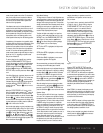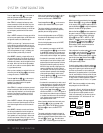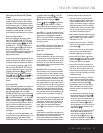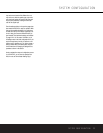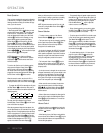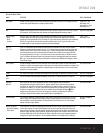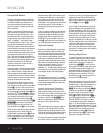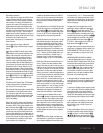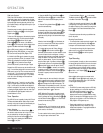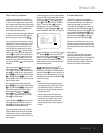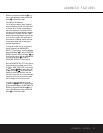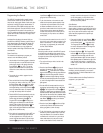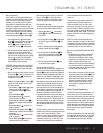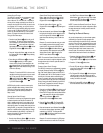
OPERATION 27
OPERATION
Digital Status Indicators
When a digital source is playing, the AVR 225 senses
the type of bitstream data that is present. Using this
information, the correct surround mode will automati-
cally be selected. For example, DTS bitstreams will
cause the unit to switch to DTS decoding, and Dolby
Digital bitstreams will enable Dolby Digital decoding.
When the unit senses PCM data from CDs or LDs, you
may select any of the standard surround modes, such
as Dolby Pro Logic II or Logic 7. Since the range of
available surround modes is dependent on the type of
digital data that is present, the AVR 225 uses a variety
of indicators to let you know what type of
signal is present. This will help you to understand the
choice of modes.
When a digital source is playing, a Bitstream
Indicator A will light to show which type of signal is
playing:
D: When the DOLBY D indicator lights, a Dolby
Digital bitstream is being received. Depending on the
settings on the source player and specific surround
information and number of channels on the disc, a
number of surround modes are possible. For discs
with full 5.1 audio, only the Dolby Digital and VMAx
modes are available.When the Dolby Digital signal is
only two-channel, you may also select from the Logic 7
Cinema/Music, Hall 1/2,Theater, Dolby Pro Logic II
Movie, Music or Emulation, or Dolby 3 Stereo modes.
When the AVR 225 senses a 2.0-channel Dolby Digital
signal, the unit will automatically select Dolby Pro Logic II
as the surround processing mode, and both the Dolby
Digital C and Dolby Pro Logic II D
indicators will
light in accordance with the requirements of Dolby
Laboratories.
DTS: When the DTS indicator lights, a DTS bitstream
is being received. When the unit senses this type of
data, only the DTS mode may be used.
PCM: When the PCM indicator lights, a standard Pulse
Code Modulation, or PCM, signal is being received.
This is the type of digital audio used by conventional
compact disc and laser disc recordings.When a PCM
bitstream is present, all modes except Dolby Digital
and DTS are available.
When a high-resolution, 96kHz/24-bit PCM signal is
detected, the current source input followed by 96k
(for example, DVD/96k) will be displayed in the
Main Information Display S. This type of program
material can be found on specially marked discs that
were recorded using a higher sampling rate than the
44kHz or 48kHz typically used on compact discs.The
Stereo-Digital (Surround Off) mode will be available to
process a 96/24 signal. The Stereo-Analog mode will
not be available since, by definition, a 96/24 signal
may be supplied only via a digital input.
In addition to the bitstream indicators, the AVR 225
features a set of unique channel-input indicators that
tell you how many channels of digital information are
being received and/or whether the digital signal is
interrupted.
These indicators are the L/C/R/LS/RS/LFE letters that
are inside the center boxes of the Speaker/Channel
Input Indicators L in the front-panel Main Infor-
mation Display Û. When a standard analog signal
is in use, only the “L” and “R” indicators will light, as
analog signals have only left and right channels.
Digital signals, however, may have two, five or six sep-
arate channels, depending on the program material,
the method of transmission and the way in which it
was encoded. When a digital signal is playing, the let-
ters in these indicators will light in response to the
specific signal being received. It is important to note
that although Dolby Digital, for example, is referred to
as a “5.1” system, not all Dolby Digital DVDs or pro-
grams are encoded with 5.1 channels.Thus, it is
sometimes normal for a DVD with a Dolby Digital
soundtrack to trigger only the “L” and “R” indicators.
NOTE: Many DVD discs are recorded with both “5.1”
and “2.0” versions of the same soundtrack. When
playing a DVD, always be certain to check the type of
material on the disc. Most discs show this information
in the form of a listing or icon on the back of the disc
jacket. When a disc does offer multiple soundtrack
choices, you may have to make some adjustments to
your DVD player (usually with the “Audio Select” button
or in a menu screen on the disc) to send a full 5.1
feed to the AVR 225. It is also possible for the type of
signal feed to change during the course of a DVD
playback. In some cases the previews of special mate-
rial will only be recorded in 2.0 audio, while the main
feature is available in 5.1 audio.As long as your DVD
player is set for 6-channel output, the AVR 225 will
automatically sense changes to the bitstream and
channel count and reflect them in these indicators.
The letters used by the Speaker/Channel Input
Indicators L also flash to indicate when a bitstream
has been interrupted. This will happen when a digital
input source is selected before the playback starts, or
when a digital source such as a DVD is paused. The
flashing indicators remind you that the playback has
stopped due to the absence of a digital signal and not
through any fault of the AVR 225.This is normal, and
the digital playback will resume once the playback is
started again.
Night Mode
A special feature of Dolby Digital is the Night mode,
which enables AC-3 input sources to be played back
with full dialogue intelligibility while reducing the mini-
mum peak level by
1
/4 to
1
/3. This prevents abruptly
loud transitions from disturbing others, without reduc-
ing the impact of the digital source.The Night mode is
available only when Dolby Digital signals with special
data are being played.
The Night mode may be engaged when a Dolby
Digital DVD is playing by pressing the Night Mode
Button k on the remote. Next, press the
⁄
/
¤
Buttons mq to select either the middle range or
full-compression versions of the Night mode.To turn
the Night mode off, press the
⁄
/
¤
Buttons mq
until the message in the lower third of the video dis-
play and the Main Information Display S reads
D-R Off. When the Night mode is active, the
Night Mode Indicator K will also light.
The Night mode may also be selected to always be on
at either level of compression using the options in the
SURROUND SETUP menu (Figure 4). See
page 19 for information on using the menus to set
this option.
IMPORTANT NOTES ON DIGITAL PLAYBACK:
1. When the digital playback source is stopped, or in a
Pause, Fast Forward or Chapter Search mode, the dig-
ital audio data will momentarily stop, and the channel
position letters inside the Speaker/Channel Input
Indicators L will flash. This is normal and does not
indicate a problem with either the AVR 225 or the
source machine.The AVR 225 will return to digital
playback as soon as the data is available and when
the machine is in a standard play mode.
2.Although the AVR 225 will decode virtually all DVD
movies, CDs and HDTV sources, it is possible that some
future digital sources may not be compatible with the
AVR 225.
3. Note that not all digitally encoded programs contain
full 5.1-channel audio. Consult the program guide that
accompanies the DVD or laser disc to determine
which type of audio has been recorded on the disc.
The AVR 225 will automatically sense the type of digital
surround encoding used and adjust to accommodate it.
4. When a digital source is playing, you may not be
able to select some of the analog surround modes
such as Dolby Pro Logic II, Dolby 3 Stereo, Hall,
Theater or Logic 7.
5. When a Dolby Digital or DTS source is playing, it is
not possible to make an analog recording using the
Tape ¢ and Video 1 or Video 2 Outputs dg
. However, the digital signals will be
passed through to the Digital Audio Outputs ‡°.
39
38
35
34



